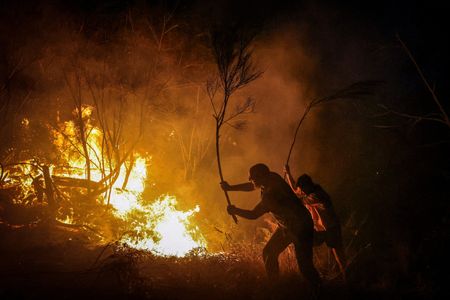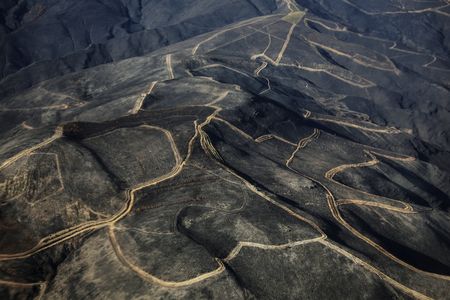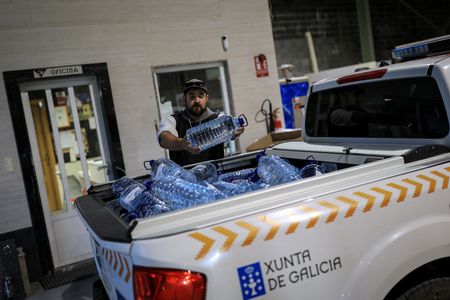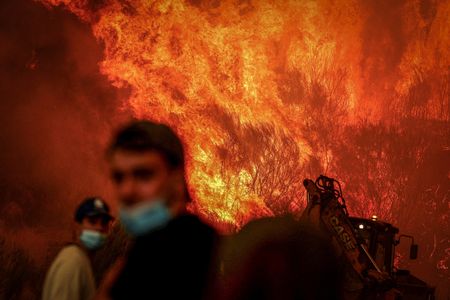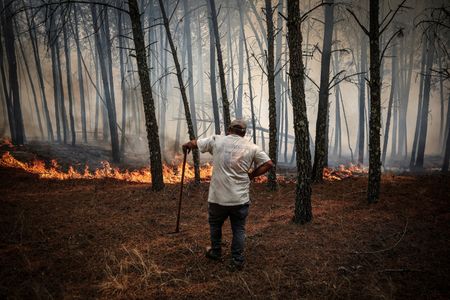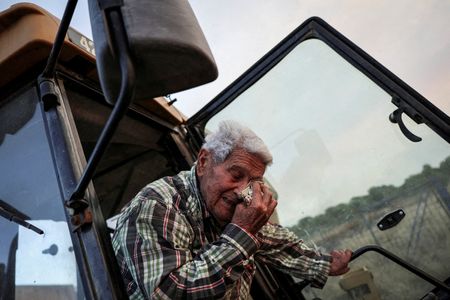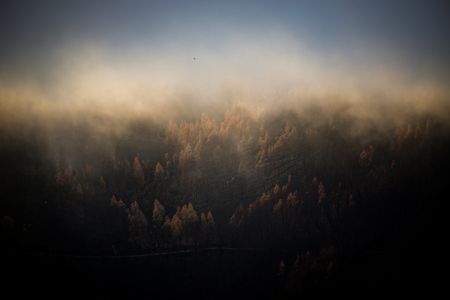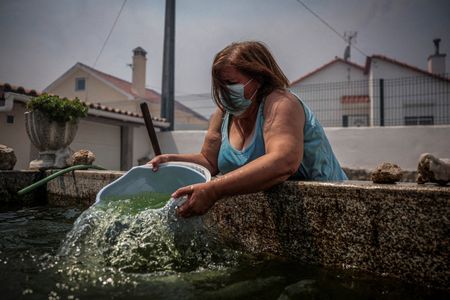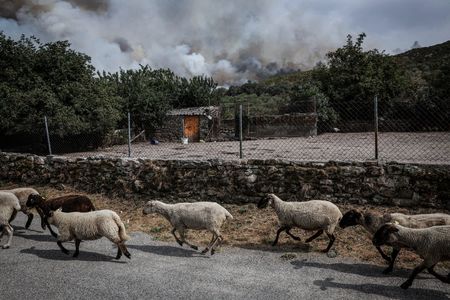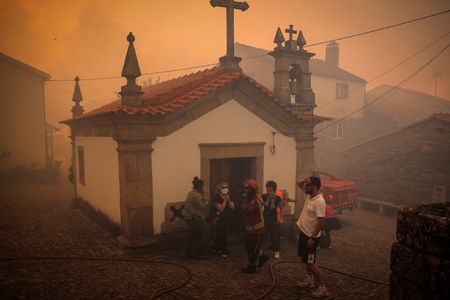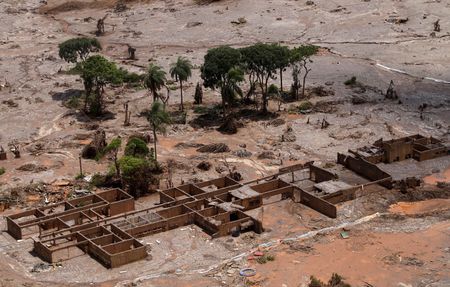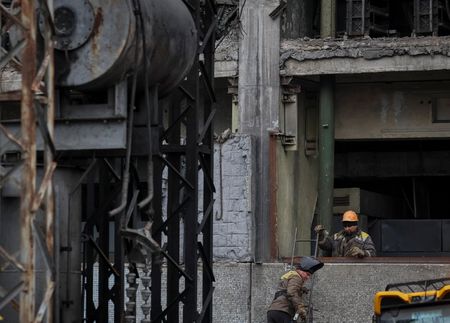By Nacho Doce, Violeta Santos Moura, Pedro Nunes and Ali Withers
GALICIA, Spain, Nov 14 (Reuters)
Photo essay: See here
“The fire started on my birthday,” says taxi driver Simon Rodriguez, hauling jugs of water out of the back of a car four months later. “And here we are, fighting it!”
Although the record-breaking wildfires that ripped across Spain and Portugal in August have subsided, residents in rural communities in Spain’s northwestern Galicia region are still battling the aftermath.
Now it is water contamination as autumn rains wash ash and sediment down denuded hillsides, clogging waterways and making drinking water unsafe.
“We can’t shower because the water is completely black. I haven’t showered in two days. We have to wait for the rain to stop before we can shower,” Rodriguez, 33, says while delivering drinking water to residents in the municipality of Villamartín de Valdeorras, who have been advised since late October to avoid using water for cooking or drinking.
As governments and business leaders meet for the annual UN climate negotiations in Brazil, where a key focus of the talks is providing financing to adapt to climate change, communities globally are reeling from the worsening impacts of rising global emissions on their homes and livelihoods, calling on governments to spend and do more to repair the damage.
ASH CLOGS NATURAL WATER FILTERS
In Galicia, as the seasonal October rains picked up, the entire vegetative layer which had turned to ash began to clog the sandtraps — known locally as areneros — that decant rainwater to prevent debris from reaching the water line, feeding the reservoir.
Local crews hike in three times daily to scoop out heavy sediment, but it has become practically impossible to deliver water in an acceptable condition to residents, Villamartín de Valdeorras Council Mayor Enrique Álvarez Barreiro said.
“We have been here for almost a month, working to remove the ash mixed with mud,” said Raul Lopez, a worker for the municipality.
“We have never seen a disaster like this before in our lives … Neither my grandfather nor my father, nor anyone else, can remember a disaster like this.”
Summer wildfires are common in Spain and neighbouring Portugal and are essential to the local ecosystem, helping to regenerate the land.
But climate change made the hot, dry and windy weather that fueled the deadly wildfires in Spain and Portugal 40 times more likely, according to scientists with World Weather Attribution.
“What happened here is crazy,” said Cristina Santín, a biologist from northwestern Spain who studies fire impacts. “Suddenly you get up one day and your home region is burning on a scale that is completely unprecedented.”
HOMES REDUCED TO RUBBLE
The fires forced more than 42,000 people across Spain to evacuate, according to the Ministry of Interior, with some returning to find their homes had been reduced to ashes.
When Susana Fernandez Gonzalez came back to her family home in San Pedro de Cansoles, in Castilla y Leon, she described it “as if a bomb was dropped (on the village).”
The civil guard and psychologists had escorted them back in, she said. “Everything was shattered.”
The smoke plume from the Iberian fires severely degraded local air quality with the impact felt across parts of France, the UK and Ireland, according to Mark Parrington, a senior scientist with Copernicus Atmosphere Monitoring Service.
Spain’s COAG national farmers’ association estimated that the fires had caused at least 600 million euros ($699.72 million) in damages, devastating crops and buildings and leaving livestock dead in the fields.
Beekeepers also lost over 7,000 hives, COAG said, though this loss may increase with no food available to the bees from lack of vegetation.
WILDFIRES PUSH EMISSIONS TO RECORD LEVELS
As a result of the fires in Spain and Portugal, total estimated emissions across Europe and the UK were the highest on record in the Copernicus Atmosphere Monitoring Service’s dataset, which has monitored global emissions of wildfires since 2003.
Spain is grappling with how to improve forest management across areas where the local population has shrunk and the countryside has rewilded with limited controls.
Prime Minister Pedro Sanchez has acknowledged that more efforts were needed to prevent wildfires and pledged to do whatever it takes to ensure fires on such a scale never happened again.
With the natural vegetative sponge layer of Galicia’s hillsides reduced to ash, locals are concerned about water shortages in years ahead, as the rainfall is carried into streams and rivers, instead of percolating into the local aquifer.
That ash also makes its way to the sea.
“Everyone knows that ash is a problem for shellfish along all the coasts. So the problem doesn’t end for us,” said Álvarez Barreiro.
In the near term, the hillsides are unfit for livestock to graze.
Álvarez Barreiro’s municipality is planning to take protective measures by using drones to plant seeds to protect the areneros. It will cost about 12,000 euros ($14,000) for an area of approximately 40 hectares.
“I think we’re very far from addressing the vastness of the problem,” he said.
($1 = 0.8575 euros)
($1 = 0.8575 euros)
(Reporting by Nacho Doce, Violeta Santos Moura, Pedro Nunes, Ali Withers; Additional reporting by David Latona ; Editing by Sharon Singleton)

